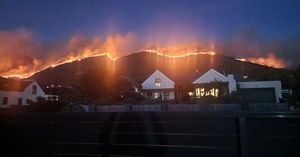In the wake of the 2025 federal election held on April 28, Canada has charted a course for the future with the Liberal Party of Canada (PLC) poised to lead the next government. Mark Carney, the party leader, has secured his seat in Nepean, Ontario, and is set to continue as Prime Minister. Following 36 days of campaigning, voters across the country cast their ballots, culminating in a night filled with anticipation and significant political shifts.
As results began to trickle in, it became clear that the PLC had won or was leading in 164 ridings, while the Conservative Party of Canada (PCC) trailed with 146 seats. The Bloc Québécois and the New Democratic Party (NDP) followed with 23 and 9 ridings, respectively. The Green Party of Canada (PVC) managed to elect only its co-leader, Elizabeth May, in Saanich–Gulf Islands, British Columbia. At the time of reporting, the PLC had garnered 42.63% of the votes compared to the PCC's 41.71%. A total of 172 seats are needed for a majority in the House of Commons.
Carney's election was anticipated, with 338 Canada estimating a 99% chance of victory in his riding. He replaces Chandra Arya, the previous Liberal MP for Nepean, who was excluded from the 2025 campaign due to a controversial trip to India amidst diplomatic tensions. Carney's leadership during the campaign emphasized the need for a strong mandate to confront the ongoing trade war with the United States, particularly in light of tariffs imposed by former President Donald Trump.
The election night was marked by various notable victories and defeats. Pierre Paul-Hus of the PCC was re-elected in Charlesbourg-Haute-Saint-Charles, while Alexandre Boulerice of the NDP retained his seat in Rosemont—La Petite-Patrie, being the only NDP member elected in Quebec. Steven Guilbeault, another Liberal, successfully defended his position in Laurier-Sainte-Marie, defeating NDP candidate Nimâ Machouf.
In Lévis-Lotbinière, Jacques Gourde of the PCC was re-elected, and Bernard Généreux also secured his seat in Côte-du-Sud-Rivière-du-Loup-Kataskomiq-Témiscouata. Dominique Vien maintained her position as MP for Bellechasse–Les Etchemins–Lévis, while Luc Berthold held onto his seat in Mégantic–L’Érable–Lotbinière. These results indicate a solid performance by the PCC in Chaudière-Appalaches, maintaining all their seats in the region.
Further north, Gérard Deltell won in Louis-Saint-Laurent–Akiawenhrahk, and Joël Godin will return to represent Portneuf–Jacques-Cartier. The election also saw Nathalie Provost, a survivor of the Polytechnique tragedy, elected in Châteauguay, marking a significant moment in Canadian politics.
As the dust settled, it became clear that the Liberals would form the next government, although it remained uncertain whether they would achieve a majority or minority status. The results were still being counted, and early indicators suggested a tight race between the PLC and PCC.
In the midst of this political landscape, the election was conducted under the shadow of a trade war with the United States, which featured prominently in the campaigns. Trump’s comments regarding the annexation of Canada resonated with voters and candidates alike, influencing the political discourse leading up to the election.
Mark Carney’s leadership style and experience were highlighted throughout the campaign, as he sought to reassure Canadians that he was equipped to handle the challenges posed by the U.S. administration. At a rally in Ottawa, he called for a "strong mandate" to navigate these turbulent waters, a message that resonated with many voters.
The night of the election saw various leaders celebrating or regrouping in their respective gatherings. Carney and his supporters gathered at Place TD in Ottawa, while Conservative leader Pierre Poilievre hosted his own event nearby, both men vying to present their visions for Canada’s future.
Meanwhile, Yves-François Blanchet, leader of the Bloc Québécois, celebrated his re-election in Beloeil–Chambly, emphasizing his party's role in providing a counterbalance to a potentially overwhelming Liberal mandate. Jagmeet Singh, leader of the NDP, faced a challenging night, with projections indicating a significant uphill battle in his riding of Burnaby-Central.
In terms of voter engagement, the election saw a notable increase in advance voting, with 7.3 million Canadians participating, a 25% rise compared to the 2021 federal election. This surge in early voting reflects a growing interest in the political process and indicates that Canadians are eager to make their voices heard.
The results from Trois-Rivières showed a competitive landscape, with Caroline Desrochers of the PLC leading with 2,993 votes, followed by Yves Levesque of the PCC with 1,931 votes. In Saint-Maurice–Champlain, François-Philippe Champagne of the PLC secured his fourth term with a convincing lead.
As the final results are tallied, the implications of this election will unfold in the coming days and weeks. With the Liberals set to lead the government, questions remain about the nature of their mandate and how they will address the pressing issues facing Canadians, particularly in light of the ongoing trade tensions and domestic challenges.
In summary, the 2025 federal election has set the stage for a new chapter in Canadian politics, with the Liberal Party at the helm and a diverse array of voices represented in the House of Commons. The political landscape is shifting, and all eyes will be on how the new government navigates the complexities of governance in a challenging global environment.

![[EN DIRECT] Suivez notre couverture des élections fédérales 2025](https://thumbor.evrimagaci.org/PPaQ4YXJn17pVA4h8X6p7g3M9uI=/200x0/tpg%2Fsources%2Fedc7e011-ac62-4e6c-a1b0-a67def66f7e4.jpeg)



